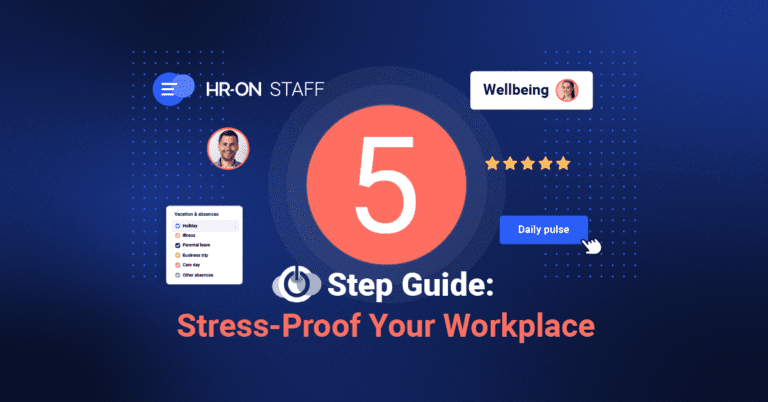Stress-Proof Your Workplace: A 5-Step Guide for HR Managers
While it’s the employer’s responsibility to prevent long-term stress in the workplace, every employee has a part to play, especially those in HR. Are you working in HR? Read on and get equipped with five steps to stress-proof the workplace.
Being in a constate state of stress can affect an employee mentally and physically. Everyone can experience stress, but there’s a difference between short-term and long-term stress. While short-term stress has a limited duration and can even be stimulating, long-term stress is destructive and can lead to other illnesses.
Stress is the body’s response to pressure caused by external or internal demands. When and how stress is triggered depends on each individual, but ignoring the signs our body gives us is a big no-no. Many of us have perhaps experienced work stress to some degree.
Employees shouldn’t deal with stress alone – HR plays a critical role in addressing stress in the workplace. As the employer is responsible for preventing prolonged stress, HR managers are instrumental in ensuring employees receive the necessary guidance to manage stress effectively. As an HR manager, you should take on the organization’s knowledge repository role with a deep understanding of how best to support employees experiencing stress.
Read along and get five tips on how to stress-proof the workplace. Keep in mind that these tips may not fit all – altering them is the best solution.
1) Be Attentive to Well-Being Daily
One of the important tasks HR has, is to prevent work-related stress, and be proactive, ensuring that employees thrive daily. It includes continuous dialogues with employees about, for instance, the amount of work tasks, personal and professional development, social well-being, and professional relationships with managers.
One-on-one conversations can be highly beneficial for HR managers. These conversations involve sitting down with employees and actively listening to them as they share their thoughts, concerns, and feedback. These conversations should be approached with the understanding that everything discussed is confidential. It’s essential to take the employee’s input seriously and work together to create the best possible work environment for them. By fostering an open and supportive dialogue, HR managers can build stronger relationships with employees, create a positive work culture, and minimize stress.
When managers or HR professionals demonstrate interest and concern, employees typically feel greater security and confidence in their jobs, and it becomes easier to open up when things get tough. HR managers need to communicate that they’re always available for informal conversations if an employee needs it.
2) Identify the Early Signs of Stress
Typical signs of stress include forgetfulness and difficulty concentrating, often resulting in missed appointments or deadlines. In addition, some employees may respond by demanding more attention, speaking loudly, and acting frantically, while others may withdraw and avoid meetings altogether.
A stressed employee may seem disengaged and begin to neglect tasks, appearing tired and more irritable than usual due to poor sleep caused by stress. As an HR manager, it’s essential to be aware of these signs and take action to address them promptly, ensuring a healthy and productive workplace.
3) Keep Track of Key Employees in the Workplace
Should the unfortunate happen and an employee is negatively stressed for too long, several key employees can step in and help. Let HR keep track of the key employees so the workplace immediately has an action help plan. These employees are:
- Members of the management/department team
- The specific employee’s manager
- Employee representative
- Health and safety representative
As the HR manager, one of your responsibilities is to organize the key employees and assist them and the stressed employee, ensuring that a process is happening. Collect all relevant information about the key employees, inform the key employees how to manage stressful situations, and lastly, provide the key employees with relevant internal and external resources.
4) Be Ready With Internal and External Help
Helping a stressed employee goes beyond internal support. While you can do much in your organization to prevent negative stress, incorporating external help and resources can be a valuable asset. Provide access to specialized expertise and services that your organization may not have, such as stress management training, counseling, and coaching.
By engaging external support, you can ensure that your employees receive the best care and support during stressful periods, ultimately leading to a healthier, happier, and more productive workforce.
If you become aware of the challenge early on, you can help the employee by taking various measures. It could be offering them reduced working hours and arranging meetings with a stress coach. You can also assist by helping prioritize the employee’s tasks. It may be necessary to assign tasks to someone else temporarily so there’re fewer things the stressed employee has to think about. Doing so removes some pressure but reassure the employee that they’ll get their tasks back when the time is right.
5) Be Patient
If one of your employees is absent due to stress, be prepared to help them return to work when the time is right. It should be done at a pace that considers the employee’s needs fully.
Start by offering the employee the option to return to work on reduced hours. Remember to be patient and offer tasks with extended deadlines and the possibility to decide how much should be done in collaboration with colleagues or by oneself.
Then, gradually increase working hours and tasks. Remember to be in dialogue with the employee constantly. Give each other status and feedback on the situation, and develop any necessary changes or additions.
Patience, openminded, and a positive attitude signal trust. At the end of the day, trusting one another, and knowing who we can go to when it’s difficult, can make a significant difference in the outcome of a stressful situation. If you haven’t established any process to stress-proof your organization for negative stress, we suggest that you slowly but surely, establish steps and processes beneficial to the entire staff.
Stress-Profing With HR-ON
If you are HR-ON customer and have access to HR-ON Staff, there are a range of tools that can support your work in preventing stress. This includes the Engagement Builder. Create an Engagement that can contain questions, videos, images, links to the employee handbook, the ability to sign digitally, and much more.
An Engagement is perfect to send to an employee prior to a one-to-one meeting. Additionally, it can serve as a supplementary tool to check in with employees on their well-being. Several of our customers also use the tool for employee development conversations.
If you aren’t a customer yet but would like to explore HR-ON’s platforms, HR-ON Recruit and HR-ON Staff, book a free demo today.


